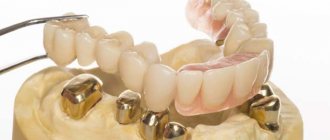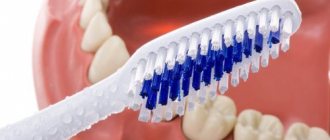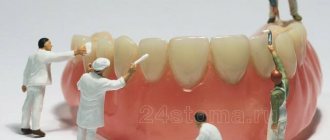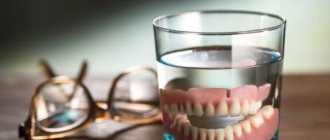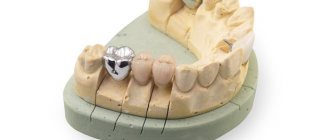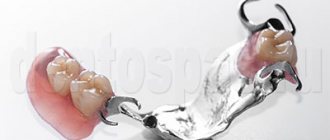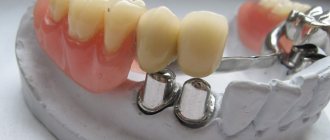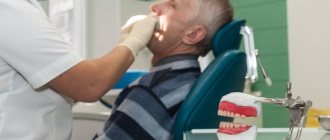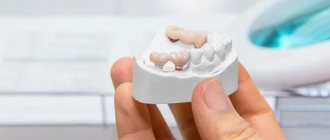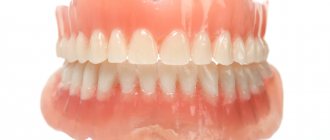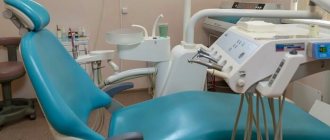- Design of a removable lamellar prosthesis
- Removable plate denture price
- When are plate dentures used?
- Advantages and disadvantages of plate prostheses
- Removable plate dentures in Moscow
Partially removable laminar dentures, outwardly indistinguishable from real teeth, will help restore the beauty of a smile and restore chewing functions after the loss of several teeth. The plate prosthesis is accessible, functional, and practical, but you need to get used to it so as not to feel discomfort.
Plate prosthesis - what is it and what does it look like?
This is a removable prosthetic structure consisting of a base (made of polymer compounds) and artificial crowns. Some models are equipped with locking elements. As a rule, such prostheses are made of acrylic, polyurethane composition or a nylon base. The final price of the structure depends on the choice of prosthesis material.
Plate dentures are installed in the following cases:
- when a person is missing several teeth or is completely edentulous;
- if it is not possible to perform classical implantation with subsequent prosthetics (for example, with certain contraindications or with limited funds);
- when the patient is allergic to metal alloys;
- when it is impossible to install classic “bridges” or clasp dentures;
- if you need to wear a temporary prosthesis while a permanent one is being made, or dental implants are taking root.
It is important!
A good removable denture structure made from high-quality materials is manufactured strictly in accordance with the individual parameters of the patient’s upper and lower jaw. Standard (ready-made) dentures will never work!
The presented removable dentures are not recommended for installation if the patient has gum disease in the acute stage, suffers from diseases of the circulatory system, or has mental disorders. Also, these prostheses are not recommended for use during chemotherapy in patients with cancer. Prosthetics should be postponed to the future if, at the time of installation of new teeth, a person is diagnosed with inflammatory processes in the body.
The average duration of use of a removable prosthetic structure is from three to five years, but with careful use and provided that a modern prosthesis is installed on implants, it can last ten years.
Experts recommend changing the prosthesis on time, since over time, due to pressure, deformation of the gums occurs, the prosthesis “sags,” the clasps become loose, the material wears out and cannot cope with the distribution of the chewing load, and most importantly, the design no longer copes with its tasks, bone atrophy occurs fabrics.
When to use
A partially removable lamellar denture will help a patient who has unexpectedly lost several teeth. They are placed for a short period of time while permanent bridges are made for the patient. The main indications for wearing such a prosthesis are:
- There are no chewing teeth, but there are well-preserved supporting teeth. The cause may be a household or sports injury, tooth extraction due to complex dental diseases.
- There is no option to install implants for any reason.
- Severe allergic reaction to components of permanent structures.
The nuances of using plate dentures
- Relative fragility. There is a high risk of deformation under significant loads on the artificial system. If the plastic structure is used carefully and not loaded with solid food, it will last for the entire period of use.
- There are problems with getting used to it and discomfort when wearing it. This is due to pressure on the gums, as well as the large size of the base. At first, there may be problems with diction (especially with pronouncing hissing and whistling sounds). However, modern dental technologies do not stand still - the most comfortable systems are manufactured, which you get used to very quickly, and which do not injure your gums.
- There is no load on the bone. However, if you install a removable prosthetic structure supported by metal implants, the load will be distributed on the bone tissue.
Types of plate prostheses - key types, capabilities, features, advantages of each of them
1. Complete – a denture that is a worthy replacement for the upper and lower jaws. The main feature of the prosthetic design is the large base, which allows the system to be securely secured in the mouth.
Fixation options:
- on locks - allow you to secure a removable denture if there are at least two healthy teeth in the jaw;
- on suction cups – fixation is achieved by creating a vacuum between the prosthesis and the oral mucosa;
Note!
To more reliably attach the structure to the mucous membrane, special gels and creams are used. This is especially true for the bottom row.
- on screwed-in implants instead of chewing teeth - one of the best fixation options, when the prosthesis “clings” to several embedded titanium roots. But this option for attaching a prosthesis has one drawback - the price of implants installed can be several times higher than the cost of the prosthesis itself.
2. A partial is a plate prosthesis that allows you to replace one or several teeth in a row. The main advantage of such a partial denture is that you do not need to prepare healthy teeth to fix it. Modern clasp systems guarantee strong fixation.
Fixation options:
- on metal-free clasps - an improved version of classic metal clasps, the elements are made of soft materials;
- on metal clasps there are hooks that are built into the base of the partial system and “cling” to the cervical area of a healthy tooth. Today they are used extremely rarely, since there is a high risk of damaging the surface of a living tooth;
- Attachments are locking fixing systems that are placed on both a removable partial denture and a healthy tooth. When fixing, a characteristic click is heard, indicating that the partial system is securely fastened.
The most frequently asked questions about partial dentures
Is an allergy possible? How long does it take to get used to? Do you need fixing gels when wearing? You can find out the answers to these and other most popular questions in this section of the article.
— Is it possible to have an allergic reaction?
Is it possible. As a rule, an allergy can occur to acrylic when wearing plate dentures. Or on metal if wearing a clasp design. Before installing a prosthesis, a doctor may recommend that particularly sensitive people undergo a special test for sensitivity to materials.
— How long does it take to get used to it?
Sometimes it can take up to 3-4 weeks to get used to it. This usually applies to plate dentures, since they are more noticeable in the oral cavity. Clasp designs do not require so much time.
— Do I need to use fixing gels when wearing partial structures?
Partial structures do not require additional fixation, since they already have fastenings (hooks or clasps).
— Do I need to take off my dentures at night?
It is not at all necessary to remove the structure at night. It is not even recommended to remove the prosthesis for the first 3-4 weeks after installation, since there is an adaptation period. Further, at the discretion of the patient.
— Are there any restrictions when wearing?
Avoid eating excessively hard foods such as nuts or ice. It is also not recommended to eat foods that are too viscous and stick to artificial teeth.
How a plate prosthesis is created - the process in stages
Stage No. 1 – consultation with a dentist and prosthetist, planning of prosthetics. The patient is also sent to take panoramic photographs of the jaw; the type of structure (full or partial) and the material from which the prosthesis will be made are specified.
Stage No. 2 - the dentist takes impressions of the jaw, evaluates the bite, and sends the data to the technical laboratory, where the prosthetic structure will be created.
Stage No. 3 – fitting and correction of the position of the test structure of the prosthesis made of wax.
Stage No. 4 is the process of “adjusting” the finished prosthesis to the individual parameters of the jaw.
Stage No. 5 – “fitting” the finished removable plastic prosthesis, checking the strength of fixation.
Note!
When compared with other options for creating structures, the plate one is made relatively simply and quickly. The patient can count on quickly receiving a prosthesis, which is important when installing a temporary solution (during the healing of implants).
How much does a plate prosthesis cost?
The average price of a partial plate denture made of plastic with crowns is 10 thousand rubles. The most expensive options for complete systems will cost about 49 thousand, respectively. It is possible to choose a solution in the mid-price category - up to thirty thousand rubles. If a partial or complete removable denture with crowns is placed on artificial implants, the amount of prosthetics can be increased by approximately fifty thousand rubles.
The cost of a removable prosthetic structure includes:
- diagnostics of teeth and gums;
- making casts;
- production of the denture itself;
- fitting and adjustment of the system to the individual parameters of the patient;
- correction and possible relining of the prosthesis.
The price of a plate denture depends on the type, material, type of fastening, the number of missing teeth, the need for implants and the general condition of the patient’s oral cavity.
Now let's summarize
Thus, we examined the key points characterizing the process of installing removable lamellar prostheses (plate dentures), got acquainted with their structure, learned about the “pros” and “cons,” and also studied in what cases this type of prosthetics is prescribed.
If you would like to receive more detailed information about the specifics of using plate structures, please contact the Elident clinic. We will give you comprehensive information and help you choose the appropriate denture option.
An attentive approach to each visitor, a flexible pricing policy, the latest materials, highly qualified staff, a cozy environment and professional installation of all types of dental structures - these are just some of the benefits that you can count on when you contact our clinic.
Article expert (author):
Expert opinion
Despite all the positive possibilities and nuances of using prosthetic structures, this is the optimal solution for replacing missing teeth on a limited budget. With such a prosthesis, it is possible to smile, chew food, and talk freely.
The 32 Dent clinic specializes in installing removable dentures for patients, including plate dentures made of plastic, nylon, and ceramic crowns. Sign up for a free consultation with a dentist or prosthetist who will expertly perform jaw prosthetic work.
If you have a problem similar to that described in this article, be sure to contact our specialists. Don't diagnose yourself!
Why you should call us now:
- We will answer all your questions in 3 minutes
- Free consultation
- The average work experience of doctors is 12 years
- Convenient location of clinics
Single contact phone number: +7
Make an appointment
Sources:
- Personal experience as an orthopedic dentist;
- Abdurakhmanov, A. I. Materials and technologies in orthopedic dentistry. Textbook / A.I. Abdurakhmanov, O.R. Kurbanov. - M.: Medicine, 2002;
- Mirgazizova, M.Z. Orthopedic dentistry / Edited by V.N. Kopeikina, M.Z. Mirgazizova. - M.: Medicine, 2001;
- Trezubov, V.N. Orthopedic dentistry. Applied materials science / V.N. Trezubov, M.Z. Shteyngart. - M.: St. Petersburg: SpetsLit; 3rd edition, 2003;
- Lebedenko I.Yu., Kalamkarova S.Kh. Orthopedic dentistry: diagnostic and treatment algorithms. - M.: Medical Information Agency, 2008;
- Ronauk, SinghTapan Singh and Jatinder Pal Singh Maxillofacial Materials – Then And Now / Ronauk Singh, Tapan Singh and Jatinder Pal Singh. - M.: LAP Lambert Academic Publishing, 2014;
- Arnold Hohmann - Principles of Design and Fabrication in Prosthodontics (2016);
- Guide to prosthetic dentistry. Prosthetics in the absence of teeth / ed. I.Yu. Lebedenko, E.S. Kalivradzhiyan, T.I. Ibragimova, E.A. Bra-gina. - M.: Medical Press LLC, 2008;
- Trezubov V.N., Mishnev L.M., Neznanova N.Yu. [and etc.]. Orthopedic dentistry. Technology of therapeutic and preventive devices. - St. Petersburg: SpetsLit, 2002.
